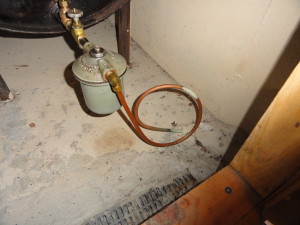The Radon Debacle
On a recent home inspection the radon test came back high at 7.3 pCi/L (picocuries of radon per liter of air.) The EPA has set a national action level of 4 pCi/L (picocuries of radon per liter of air) for indoor air. The average indoor radon level is estimated to be about 1.3 pCi/L, and about 0.4 pCi/L of radon is normally found in the outside air. The property seller had the home tested for radon when she bought the house three years ago. The level at that time was 1.6pCi/L, well within the acceptable range for radon in the air. So what happened? The home-owner had an indoor foundation drain system installed. The system consisted of a series of floor drains around the perimeter of the inside of the basement. Radon that was trapped below the floor was now released into the environment. Additionally, new windows, insulation and a ridge vent were installed along with bathroom exhaust fans as per the recommendation on her last home inspection. This increased the energy efficiency of the home but created a high negative air pressure area in the living space. The exhaust fans and ventilation system were actually “drawing” air out of the basement and subsequently radon was being pulled out of the ground and into the living space. Before the radon test came back I noted a secondary and potentially even more dangerous issue. There is approximately 250 gallons of home heating oil in the oil tank located directly over a floor drain. A drain tied to a sump pump that discharges to the front yard right in front of a storm drain. Can you imagine if that tank ever leaked and all that oil was pumped outside? A radon mitigation system works by soil suction and pulls radon from beneath the house and vents it to the exterior. In order for that to work, the new foundation drain system will have to be filled in with concrete. That solves the oil into the drain scenario but leaves her with the original problem of water in the basement. Recommendations: Fix the gutters and drainpipes along with improvements to yard grading. Install flashing behind the gutters to keep them from leaking and extend the drainpipes three to ten ft. away from the house. Slope the yard significantly away from the foundation and if necessary install a curtain drain around the exterior of the home. Fill in the floor drains and install a radon mitigation system. Conclusions: Everyone did their respective jobs properly. The windows, insulation, ventilation system, exhaust fans, and foundation system were all done professionally. But the house needs to be treated as a whole unit. If you change one system in the home it could affect other systems. In this case a floor drain led to radon problems and a potentially disastrous oil spill. The foundation drain installer probably knows nothing about radon and most likely didn’t even give a thought to the oil tank. The energy efficiency team that did the windows, insulation and ventilation systems did not realize that the increased “tightness” of the home could lead to increased radon levels. So who is supposed to know how the home works as a system? A really good Home Inspector does. The next time you plan a major renovation, consult with a professional Home Inspector to make sure the systems you are installing are working in harmony with one another. Photo of oil tank near floor drain
 |
|
